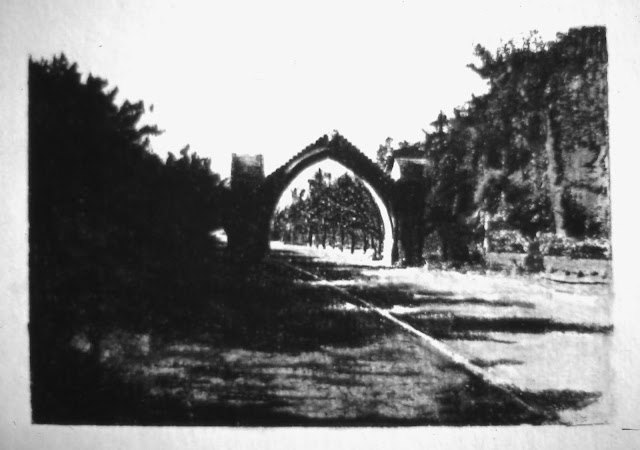This spectacular nation is an artist's dream come true, especially if you are a landscape artist (which I wasn't), but the sheer beauty of the Scottish landscape turned me into one... and over the years I produced hundreds of Scottish watercolors, pastels and drawings (and some etchings) which celebrated not only the Scottish landscape, but also all the "stuff" around me (I lived in a farmhouse built in 1532), such as sheep, horses, cows, Highland games, fish, and the brilliant Scottish people.
See some of my Scottish sheep pieces here, and enjoy the below art homages to Scotland.
 |
| North Sea, near Stonehaven, Angus, Scotland 8x10 inches. Watercolor on paper, c. 1989. In a private collection in Aberdeen, Scotland |
 |
| Loch Ness, Scotland 11x14 inches. Watercolor on paper, c. 1991. In a private collection in Montrose, Scotland |
 |
| Two Deer, near Little Keithock Farmhouse, Brechin Road, Angus, Scotland 28x40 inches. Watercolor on paper, c. 1991. In a private collection in Brechin, Scotland |
 |
| Snowfall, near Braemar, Aberdeenshire, Scotland 16x40 inches. Watercolor on paper, c. 1989. In a private collection in Braemar, Scotland |
 |
| Back Road, near Little Keithock Farmhouse, Angus, Scotland 30x40 inches. Watercolor on paper, c. 1992. In a private collection in Norfolk, Virginia |
 |
| Seagulls Following the Plow, near Edzell, Angus, Scotland 40x32 inches. Watercolor on paper, c. 1992. In a private collection in Boise, Idaho |
 |
| Road to Cairn O'Mount Pass, near Fettercairn, Angus, Scotland 30x40 inches. Watercolor on paper, c. 1990. In a private collection in Banchory, Scotland |
 |
| Seagulls following the plow, near Stonehaven, Angus, Scotland 8x10 inches. Watercolor on paper, c. 1989. In a private collection in Aberdeen, Scotland |
 |
| Back Road, near Little Keithock Farmhouse, Angus, Scotland 30x40 inches. Watercolor on paper, c. 1992. In a private collection in San Diego, California |
 |
| Back road, near Battledykes, Angus, Scotland 8x10 inches. Watercolor on paper, c. 1991. In a private collection in Aberdeen, Scotland |
 |
| Northern Lights, Back Road, near Little Keithock Farmhouse, Angus, Scotland 30x40 inches. Watercolor on paper, c. 1992. In a private collection in Seattle, Washington |
 |
| Just Before Trinity Fields, Enroute Brechin, Angus, Scotland 6x10 inches. Watercolor on paper, c. 1992. In a private collection in Dundee, Scotland |
 |
| Back Road near Smiddie Wood, near Stracathro and Careston Estates, Angus, Scotland 12x40 inches. Watercolor on paper, c. 1992. In a private collection in Brechin, Scotland |
 |
| River South Esk, near Brechin, Angus, Scotland 30x40 inches. Watercolor on paper, c. 1991. In the Collection of the Earl of Southesk |
 |
| View of the Highlands, near Edzell, Angus, Scotland 10x14 inches. Watercolor on paper, c. 1992. In a private collection in Fresno, California |
 |
| Back Road, near Little Keithock Farmhouse, Trinity, Angus, Scotland 18x36 inches. Watercolor on paper, c. 1990. In a private collection in San Francisco, California |
 |
| North Sea, near Stonehaven, Angus, Scotland 8x10 inches. Watercolor on paper, c. 1989. In a private collection in St. Cyrus, Scotland |
 |
| Road near Kirriemuir, Angus, Scotland, where my daughters would take horse riding lessons 8x10 inches. Watercolor on paper, c. 1992. In the Collection of the Earl of Southesk |
 |
| Back road near Laurencekirk, Angus, Scotland 7x10 inches. Ink wash on paper, c. 1990. In a private collection in Brechin, Scotland |
 |
| Taking the walk behind the Blue Door, The Burns, near Edzell, Angus, Scotland 8x10 inches. Watercolor on paper, c. 1991 In a private collection in the United States |
 |
| View from Little Keithock Farmhouse, near Fettercairn, Angus, Scotland 28x40 inches. Watercolor on paper, c. 1992. In a private collection in Glasgow, Scotland |
 |
| View of the Highlands, near Maryculter, Angus, Scotland 30x40 inches. Watercolor on paper, c. 1990. In a private collection in Montrose, Scotland |


























